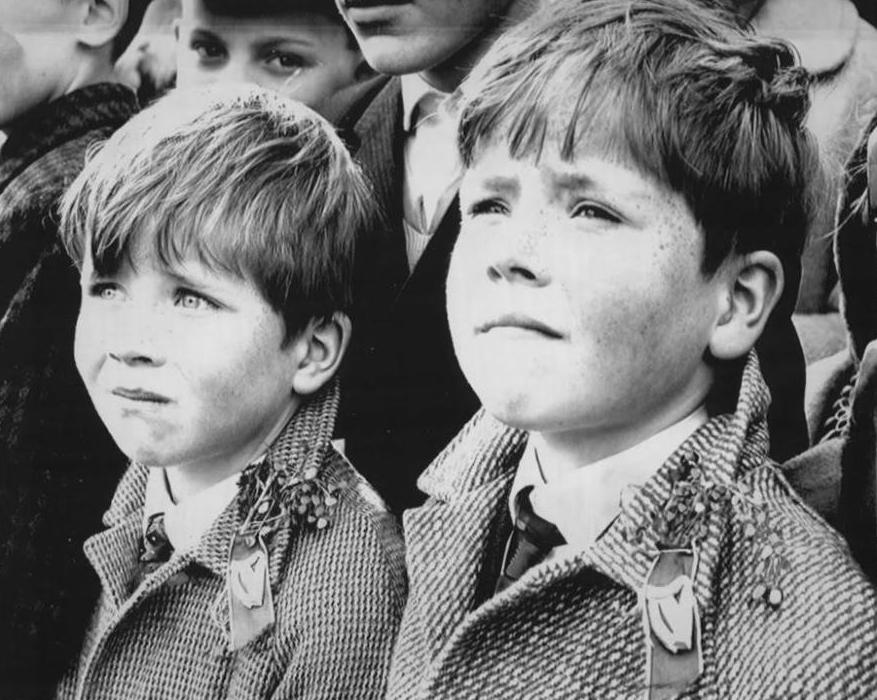
Irish Holidays

Figure 1.--Here two boys in 1972 are enjoying the St. Ptrick'd Day prade in Dublin.Here the Artane Boys Band is performing in 1974. We think that they are performming in Chicago, probably on St. Ptruck's Day. The caption read, "They're wearing the green---These young Dubliners wear shamrock decirated badges as the watch the St. Patruck'd Day Parade procession in Dublin last year. St. Patrick is susposed to have usedthe three-leaf plant in illustrating the doctrine of the Trinity."
|
|
And we have some information on holidays in Ireland. Many are comparable to holidays in other European countries, but there are several destinctive Irish holidays as well. There are nine public holidays observed in Ireland. This includes both secular and religious holidays. Ireland is strongly Catholic. As in Britain, Ireland refers to public holidays as bank holidays. This is because the banks and governmnt offices and schools as well as many business close for the day. Public transport often operates on reduced schedules. Unlike most European countries, there is no holidays honoring World War I and World War II sacrifices. The Irish supported Britain in World War I and suffered grevious losses like other beligerant countries. The modern Irish state does not honor their fallen. Ireland played no part in the defeat of the NAZIs. Ireland was neutral in World War II and even refused to open bases to the British Royal Navy to fight the U-boat threat. The Government even set a congratulartory telegram to Hitler on his Birthdays. The best know is St. Patrick's Day which is not just celebrated in Irekand, but all the countries of the Irish dispora. Hopefully our Irish readers will send information about their holiday celebratons.
New Year (January 1)
New Years is calld Lá Caille or Lá Bliana Nua.-These are the public holidays observed in Ireland.
Most also take time off work for New Year's Eve (Oíche Chinn Bliana), the day before New Year.
St. Patrick's Day (March 17)
The most Irish of all holidays of cours is Saint Patrick's Day called Lá Fhéile Pádraig. It is Ireland's national day as St Patrick was the ptron saint of Ireland. Even so, it only becane aublic holiday recently (1903). It was first widely clebrated in Boston and New York befire it became an imporant holiday in Ireland. There are celebratuins throughout Ireland. The karge prade is organized in Dublin with plentty of bands and Irish dancers.
Easter Monday (usually April)
Easter is a moveable Monday known as Luan Cásca in Ireland. It is the day after Easter Sunday (Domhnach Cásca). The religious celebration coincides with the commemoration of the Easter Rising (1916). The Rising initially geerated little public support, but this changed with the sevrity of the British repression. Good Friday (Aoine an Chéasta) is not a public holiday, though all state schools and some businesses close.
May Day (early May)
May Day is a moveable Monday and is called Lá Bealtaine. It is celebrated the first Monday in May. It was first observed as a punbic holiday in 1994.
June Holiday (early June)
This is another Moveable Monday holiday. une Holiday is called Lá Saoire i mí Mheitheamh. It is celebrated the first Monday in June. It was previously Whit Monday as in England. The name was changed in 1973. These month holidays were part of an effort to destinguish the celebrations from those observed in England.
August Holiday (early August)
this is also a moveable Monday holiday. August Holiday is known as Lá Saoire i mí Lúnasa. It is celebrated the first Monday in August.
October Holidy (late-October)
October Holiday is also a moveable Monday Holiday, It is called Lá Saoire i mí Dheireadh Fómhair. It is celebrated t The last Monday in October (Lá Saoire Oíche Shamhna). It was first observed in 1977. It replaced Guy Fawkes Day or Bon Fire Night.
Christmas (December 25)
Christmas Day is known as Lá Nollag. Most people begin Christmas celebrations on Christmas Eve (Oíche Nollag), including taking time off work. To the Irish, Christmas is a time for religious celebration rather than revelry. The manger scene is in most houses and there are a few Christmas trees. The best-known Christmas custom is that of putting a candle in the window, often decorated with some greenery, on Christmas Eve. The idea is to help light the way of the Holy Family or any other poor traveller out on such a night. After the evening meal, the table is also set with bread and milk and the door left unlocked as a symbol of hospitality that the family is offering to Mary and Joseph and the little one to come. The only festive note that is struck is in the pudding that caps the meal. Three puddings are made early in December, one each for Christmas, New Year's, and Twelfth Night. The day after Christmas is St. Stephen's Day (Lá Fhéile Stiofáin or Lá an Dreoilín) is also widely celebrated. It translates as the Day of the Wren. This witnesses the rowdy old custom of hunting the wren, when boys go from door to door with a wren on a stick (today the wren is not a real one), singing the traditional song and begging for treats.
HBC

Navigate the Boys' Historical Clothing Web Site:
[Return to the Main Irish page]
[Return to the Main holiday country page]
[Introduction]
[Activities]
[Biographies]
[Chronology]
[Clothing styles]
[Countries]
[Bibliographies]
[Contributions]
[FAQs]
[Glossaries]
[Images]
[Links]
[Registration]
[Tools]
[Boys' Clothing Home]
Navigate the Boys' Historical Clothing Irish pages:
[Return to the Main Irish page]
[Irish choirs]
[Irish dresses]
[Irish ethnic]
[Irish school uniform]
[Irish youth groups]
Navigate the Boys' Historical Clothing kilt pages:
[Main kilt page]
[Kilt suits]
[Scottish kilts]
[Scottish boys clothing]
[Scottish school uniform]
[Highland dance]
[Irish kilts]
[Irish step dancing]
[Pipe bands]
[Greek kilts]
Created: 8:58 AM 1/14/2013
Last updated: 8:58 AM 1/14/2013


